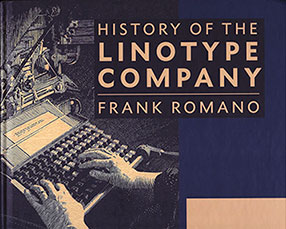History of the Linotype Company by Frank Romano released
 No single machine impacted the setting of type as did the Linotype. At the time of the Civil War, typesetting was the second most common occupation in America, surpassed only by farming. Both were done primarily by hand. The Linotype machine mechanized typesetting. Outside of Gutenberg’s invention of movable type no other single machine has had the impact on printing as has the Linotype.
No single machine impacted the setting of type as did the Linotype. At the time of the Civil War, typesetting was the second most common occupation in America, surpassed only by farming. Both were done primarily by hand. The Linotype machine mechanized typesetting. Outside of Gutenberg’s invention of movable type no other single machine has had the impact on printing as has the Linotype.
The definitive history of the machine, the people and the technology can be found in the 463 page History of the Linotype Company, released by Museum of Printing’s President Frank Romano. The book is available through the museum.
Copies are available at the museum on Saturdays from 10 am to 4 pm. If Frank is there, he will be happy to autograph your copy.
The price is $65 for members, $75 for non-members, plus tax. If you can not make it to the museum, send a check for $93 (including tax and shipping) to the Museum at 15 Thornton Ave Haverhill, MA 01832.
The History of the Linotype Company is 11 × 8½ inches in small coffee table orientation. It includes hundreds of photographs sourced from around the world, including ads, product brochures, maintenance manuals, Linotype’s periodicals and special publications and more, including many personal accounts, correspondence and memories of the company and typesetting. One of the 18 chapters is devoted solely to the business of typesetting over the last 140 years.
The Linotype machine was king for nearly seventy years, dethroned only by the “new” technology of phototypesetting. The Linotype Company was a strong leader in the creation and marketing of phototypesetting units and systems until that technology was replaced by personal computers, page make-up software and direct to plate and direct to press technologies.
A follow-up book by Romano, The History of Phototypesetting, was also published in 2014.
< Typejournal.ru | The Monotype Recorder Online >
Top ↑